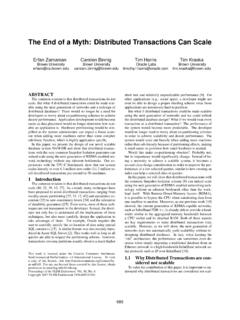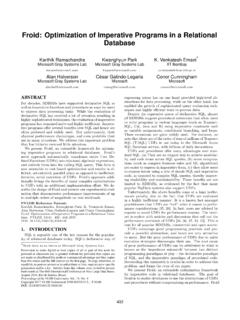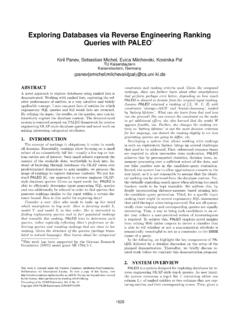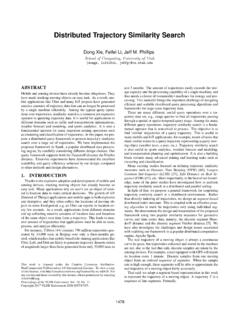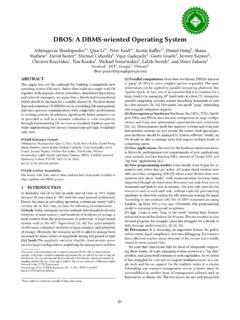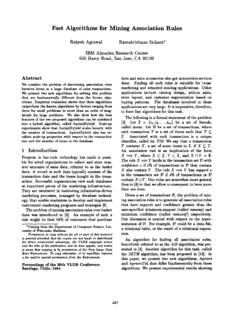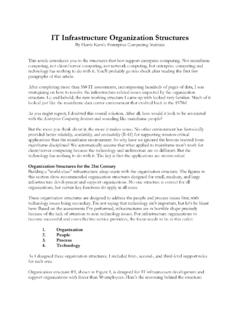Transcription of POLARIS: The Distributed SQL Engine in Azure Synapse - VLDB
1 POLARIS: The Distributed SQL Engine in Azure Synapse Josep Aguilar-Saborit, Raghu Ramakrishnan, Krish Srinivasan Kevin Bocksrocker, Ioannis Alagiannis, Mahadevan Sankara, Moe Shafiei Jose Blakeley, Girish Dasarathy, Sumeet Dash, Lazar Davidovic, Maja Damjanic, Slobodan Djunic, Nemanja Djurkic, Charles Feddersen, Cesar Galindo-Legaria, Alan Halverson, Milana Kovacevic, Nikola Kicovic, Goran Lukic, Djordje Maksimovic, Ana Manic, Nikola Markovic, Bosko Mihic, Ugljesa Milic, Marko Milojevic, Tapas Nayak, Milan Potocnik, Milos Radic, Bozidar Radivojevic, Srikumar Rangarajan, Milan Ruzic, Milan Simic, Marko Sosic, Igor Stanko, Maja Stikic, Sasa Stanojkov, Vukasin Stefanovic, Milos Sukovic, Aleksandar Tomic , Dragan Tomic, Steve Toscano, Djordje Trifunovic, Veljko Vasic, Tomer Verona, Aleksandar Vujic, Nikola Vujic, Marko Vukovic, Marko Zivanovic Microsoft Corp ABSTRACT In this paper, we describe the Polaris Distributed SQL query Engine in Azure Synapse .
2 It is the result of a multi-year project to re- architect the query processing framework in the SQL DW parallel data warehouse service, and addresses two main goals: (i) converge data warehousing and big data workloads, and (ii) separate compute and state for cloud-native execution. From a customer perspective, these goals translate into many useful features, including the ability to resize live workloads, deliver predictable performance at scale, and to efficiently handle both relational and unstructured data. Achieving these goals required many innovations, including a novel cell data abstraction, and flexible, fine-grained, task monitoring and scheduling capable of handling partial query restarts and PB-scale execution. Most importantly, while we develop a completely new scale-out framework, it is fully compatible with T-SQL and leverages decades of investment in the SQL Server single-node runtime and query optimizer.
3 The scalability of the system is highlighted by a 1PB scale run of all 22 TPC-H queries; to our knowledge, this is the first reported run with scale larger than 100TB. PVLDB Reference Format: Josep Aguilar-Saborit, Raghu Ramakrishnan et al. VLDB Conferences. PVLDB, 13(12): 3204 3216, 2020. DOI: 1. INTRODUCTION Relational data warehousing has long been the enterprise approach to data analytics, in conjunction with multi-dimensional business-intelligence (BI) tools such as Power BI and Tableau. The recent explosion in the number and diversity of data sources, together with the interest in machine learning, real-time analytics and other advanced capabilities, has made it necessary to extend traditional relational DBMS based warehouses. In contrast to the traditional approach of carefully curating data to conform to standard enterprise schemas and semantics, data lakes focus on rapidly ingesting data from many sources and give users flexible analytic tools to handle the resulting data heterogeneity and scale.
4 A common pattern is that data lakes are used for data preparation, and the results are then moved to a traditional warehouse for the phase of interactive analysis and reporting. While this pattern bridges the lake and warehouse paradigms and allows enterprises to benefit from their complementary strengths, we believe that the two approaches are converging, and that the full relational SQL tool chain (spanning data movement, catalogs, business analytics and reporting) must be supported directly over the diverse and large datasets stored in a lake; users will not want to migrate all their investments in existing tool chains. In this paper, we present the Polaris interactive relational query Engine , a key component for converging warehouses and lakes in Azure Synapse [1], with a cloud-native scale-out architecture that makes novel contributions in the following areas: Cell data abstraction: Polaris builds on the abstraction of a data cell to run efficiently on a diverse collection of data formats and storage systems.
5 The full SQL tool chain can now be brought to bear over files in the lake with on-demand interactive performance at scale, eliminating the need to move files into a warehouse. This reduces costs, simplifies data governance, and reduces time to insight. Additionally, in conjunction with a re-designed storage manager (Fido [2]) it supports the full range of query and transactional performance needed for Tier 1 warehousing workloads. Fine-grained scale-out: The highly-available micro-service architecture is based on (1) a careful packaging of data and query processing into units called tasks that can be readily moved across compute nodes and re-started at the task level; (2) widely-partitioned data with a flexible distribution model; (3) a task-level workflow-DAG that is novel in spanning multiple queries, in contrast to [3, 4, 5, 6]; and (4) a framework for fine-grained monitoring and flexible scheduling of tasks.
6 Combining scale-up and scale-out: Production-ready scale-up SQL systems offer excellent intra-partition parallelism and have been tuned for interactive queries with deep enhancements to query optimization and vectorized processing of columnar data partitions, careful control flow, and exploitation of tiered data caches. While Polaris has a new scale-out Distributed query processing architecture inspired by big data query execution frameworks, it is unique in how it combines this with SQL Server s scale-up features at each node; we thus benefit from both scale-up and scale-out. Flexible service model: Polaris has a concept of a session, which supports a spectrum of consumption models, ranging from serverless ad-hoc queries to long-standing pools or clusters.
7 Leveraging the Polaris session architecture, Azure Synapse is unique among cloud services in how it brings together serverless and reserved pools with online scaling. All data ( , files in the lake, as well as managed data in Fido [2]) are accessible from any session, and multiple sessions can This work is licensed under the Creative Commons Attribution-NonCommercial-NoDerivatives International License. To view a copy of this license, visit For any use beyond those covered by this license, obtain permission by emailing Copyright is held by the owner/author(s). Publication rights licensed to the VLDB Endowment. Proceedings of the VLDB Endowment, Vol. 13, No. 12 ISSN 2150-8097. DOI: 3204 access all underlying data concurrently.
8 Fido supports efficient transactional updates with data versioning. Related Systems The most closely related cloud services are AWS Redshift [7], Athena [8], Google Big Query [9, 10], and Snowflake [11]. Of course, on-premise data warehouses such as Exadata [12] and Teradata [13] and big data systems such as Hadoop [3, 4, 14, 15], Presto [16, 17] and Spark [5] target similar workloads (increasingly migrating to the cloud) and have architectural similarities. Converging data lakes and warehouses. Polaris represents data using a cell abstraction with two dimensions: distributions (data alignment) and partitions (data pruning). Each cell is self-contained with its own statistics, used for both global and local QO. This abstraction is the key building block enabling Polaris to abstract data stores.
9 Big Query and Snowflake support a sort key (partitions) but not distribution alignment; we discuss this further in Section 4. Service form factor. On one hand, we have reserved-capacity services such as AWS Redshift, and on the other serverless offerings such as Athena and Big Query. Snowflake and Redshift Spectrum are somewhere in the middle, with support for online scaling of the reserved capacity pool size. Leveraging the Polaris session architecture, Azure Synapse is unique in supporting both serverless and reserved pools with online scaling; the pool form factor represents the next generation of the current Azure SQL DW service, which is subsumed as part of Synapse . The same data can simultaneously be operated on from both serverless SQL and SQL pools.
10 Distributed cost-based query optimization over the data lake. Related systems such as Snowflake [11], Presto [17, 18] and LLAP [14] do query optimization, but they have not gone through the years of fine-tuning of SQL Server, whose cost-based selection of Distributed execution plans goes back to the Chrysalis project [19]. A novel aspect of Polaris is how it carefully re-factors the optimizer framework in SQL Server and enhances it to be cell-aware, in order to fully leverage the Query Optimizer (QO), which implements a rich set of execution strategies and sophisticated estimation techniques. We discuss Polaris query optimization in Section 5; this is key to the performance reported in Section 10. Massive scale-out of state-of-the-art scale-up query processor.
